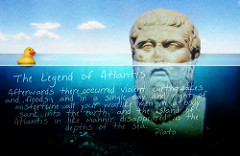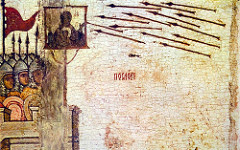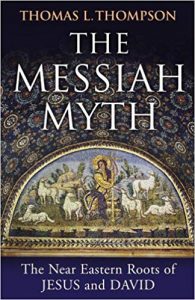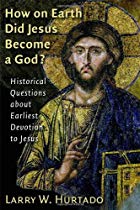I don’t recall hearing many references to the works of Philo as a source for the Gospel of Mark. Maybe there are good reasons for this that I have yet to learn.
Philo was a Jewish philosopher who lived in Alexandria, Egypt, in the early part of the first century. He would have been in his late 40’s when Jesus was supposedly 30 years old.
Last month I posted what looks to me like an instance where the author of the Gospel of Mark drew on a particular image and thought that we also find in Philo. Who said this? was about a parable or riddle of Jesus in Mark:
Nothing outside a man can make him ‘unclean’ by going into him. Rather, it is what comes out of a man that makes him ‘unclean.‘ (Mark 7:15)
In that post — and it was further elaborated with contributions from others in the comments, if I recall — I noted the same idea expressed as its converse in similar imagery:
as Plato says, mortal things find their entrance, and immortal things their exit. For into the mouth do enter meat and drink, perishable food of a perishable body; but from out of it proceed words — the immortal laws of an immortal soul, by means of which a rational life is regulated. (Philo, On the Creation, 119)
There is another saying of Jesus in the Gospel of Mark that also comes to mind when reading the same work of Philo, On the Creation (or Opus Mundi).
The Sabbath was made for man, not man for the Sabbath. (Mark 2:27)
The Jesus Seminar voted that this is something very like what Jesus probably said. Maurice Casey (Aramaic Sources of Mark’s Gospel) discussed it at length to argue that “the cultural context” should inform readers that Jesus implied that his use of “man” or “mankind” here was nonetheless applicable to Jews only. He quotes the 1947 CNT (presumably the Commentaire du Nouveau Testament?) to confirm that Jesus would not have meant to include non-Jews in this sabbath saying:
As a matter of historical fact the Sabbath was not made for man in general. At the time when the saying was uttered the sabbath was a distinctive peculiarity of the Jews: and our evidence goes to show that they regarded it as such and resented any non-Jewish observance of it. (T. W. Manson, `Mark II. 27f’, CNT 11, 1947, 138-46, at 145, followed by Beare, `Sabbath’, 132.)
He also cites the Mekhilta Shabbath I, Exod. 31:12-17:
R. Simeon ben Menasya says: Look! It says, `And you shall keep the sabbath, for it is holy to you’ (Exod. 31.14). The sabbath is delivered to you and you are not delivered to the sabbath.
That last sentence is famous for its similarity to the passage in the Gospel of Mark.
Some scholars (e.g. Casey, Crossley and no doubt others) use this late rabbinic passage as part of their efforts to set the scene for Jesus’ day. But this does not work. The Jewish Encyclopedia says R. Simeon ben Menasya was a contemporary of R. Judah ha-Nasi I, and Wikipedia informs me that he lived and died around the late second century or early third century — assuming that this Wikipedia article is about the same rabbi. So the Mekhilta does not appear to trace the saying any earlier than a rabbi who lived in the late second or early third century. To use this passage to help reconstruct the ideas floating around in the time of Jesus is a bit like taking a text from a Chinese author in today’s Singapore and attempting to use it to reconstruct a thought extant in imperial Shanghai in 1800. It may be an accurate match, but we can’t bet on it without additional evidence. It is just as likely that the late rabbinic saying found its way into Jewish thought via Christian contacts.
But Philo wrote something in the first half of the first century, in Egypt, that also suggests the same idea Mark’s gospel attributes to Jesus:
XXX. (89) But after the whole world had been completed according to the perfect nature of the number six, the Father hallowed the day following, the seventh, praising it, and calling it holy. For that day is the festival, not of one city or one country, but of all the earth; a day which alone it is right to call the day of festival for all people, and the birthday of the world. (On the Creation)
Now that to me is clear evidence that the 1947 CNT article quoted above is not the whole story when it says there is clear evidence “that they (the Jews) . . . resented any non-Jewish observance of it (the sabbath).” Philo here could hardly have resented it if gentiles celebrated the sabbath day. He suggests here that he would find gentile observance extremely praiseworthy.
And here we have a Jewish intellectual writing that the sabbath is a day that is given to all mankind. So one must ask how original is the verse in Mark?
But how likely is it that the author of Mark might have known Philo’s writings?
If we knew who wrote the gospel we could answer that without much difficulty.
Irenaeus associates the Gospel of Mark with the gnostic teacher Basilides — who happened to live in the same Alexandria as Philo a generation or two earlier. Clement of Alexandria wrote that Basilides was a disciple of Glaucias, “the interpreter of Peter”, and that he wrote a gospel himself. It’s a long shot, but one is reminded of other early “traditions” that Mark was composed from the memories of Peter. All of this is speculative, and there are other speculations from equally thin slivers of evidence that Mark was composed in Rome. There are reasons also to locate its author in Syria.
In the meantime, I think we now have two passages — closely positioned — in one work of Philo’s, On the Creation, that strike me as having resonance in the Gospel of Mark.










